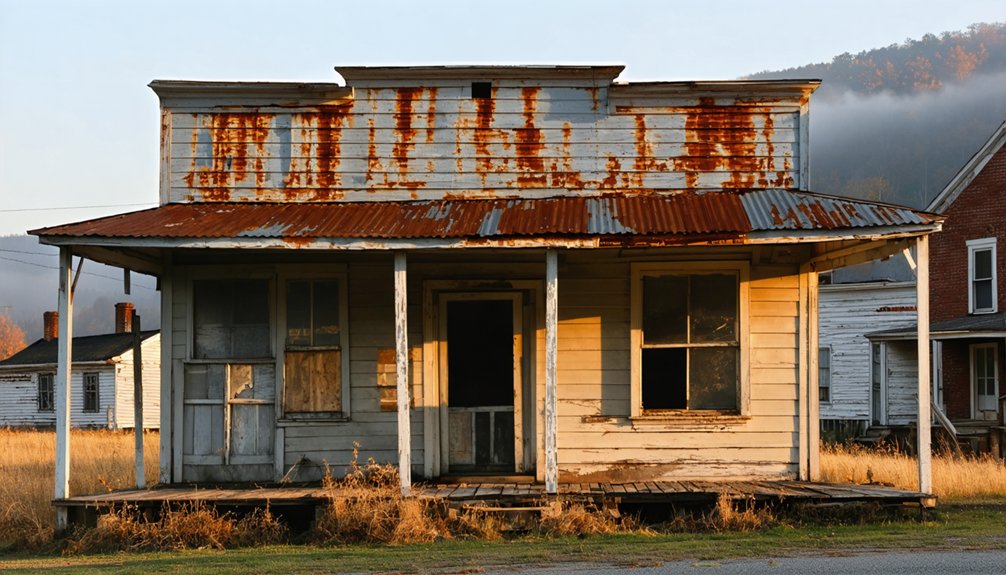You’ll find Slick Lizard hidden in Knox County’s forgotten hollows, where nature has reclaimed what was once a bustling coal town of 10,000 residents. During its 1940s peak, this unincorporated mining community thrived with worker housing, a company store, and strong family bonds forged through shared mining work. While no official markers remain today, time-worn paths and hidden foundations tell silent stories of Kentucky’s industrial past, waiting for those who venture beyond the mapped roads.
Key Takeaways
- Slick Lizard was an unincorporated mining community in Knox County, Kentucky that reached its peak population of 10,000 residents in the 1940s.
- The town featured typical coal camp amenities including worker housing, a commissary, and basic facilities for mining families.
- Economic changes and increased mechanization in coal mining led to Slick Lizard’s decline and eventual abandonment in the mid-20th century.
- No buildings or official markers remain today, as nature has reclaimed the landscape with dense forests covering former settlement areas.
- Hidden foundations and altered waterways are the only physical remnants of this ghost town, which requires local knowledge to locate.
The Rise and Fall of a Kentucky Coal Town
While many Kentucky coal towns emerged during the late 19th century’s industrial boom, Slick Lizard carved out its place in Knox County as an unincorporated mining community built around the region’s rich coal deposits.
At its peak period, the settlement would have been similar to Lynch which reached 10,000 residents in the 1940s.
You’d have found a typical company town setup – worker housing, a commissary, and basic facilities all controlled by the mining operation that brought life to this mountain hollow. The town’s layout and structures showcased the common absence of paved roads and sewers.
The community dynamics reflected the era’s coal camp culture, with families bound together by shared work in the mines and the rhythms of company town life.
Like many of its neighbors, Slick Lizard rode the waves of coal’s fortunes until economic shifts began reshaping the region. As mechanization increased and coal demand decreased mid-century, you would’ve witnessed the gradual exodus of residents, leaving behind another quiet ghost town in Kentucky’s coal country.
Life in Harlan County’s Lost Settlement
Deep in Harlan County’s rugged terrain, Slick Lizard’s residents forged a tight-knit community where daily survival meant more than just working the mines. You’d find folks supplementing their mining wages through hunting, gathering, and small-scale farming in the challenging Appalachian landscape.
Community bonds strengthened through shared labor, bartering, and communal events. Local folklore thrived in evening gatherings where tales of the mysterious Lizard Man mixed with Appalachian music and traditional storytelling. Some locals claimed to have spotted a creature with huge red eyes lurking in the surrounding woods at night. The residents organized events similar to Bordertown’s celebrations, with Wild Bunch competitions becoming a favorite pastime.
Tales of the Lizard Man echo through mountain hollers, where neighbors trade work and stories beneath starlit Kentucky skies.
You’d witness these cultural touchstones at harvest celebrations and religious meetings, where residents maintained their mountain heritage despite isolation. Life wasn’t easy – unpaved roads, basic infrastructure, and limited medical care meant relying heavily on neighbors.
The schoolhouse served as both education center and community hub, while traditional healers filled the gaps in healthcare.
From Mining Hub to Memory
As coal markets shifted in the mid-20th century, Slick Lizard’s bustling mining operations gradually ground to a halt.
You’ll find few physical traces of the once-vibrant coal camp culture that defined this Knox County settlement, where miners and their families built tight-knit bonds through shared experiences at the company store and worker housing.
The mining community dynamics that characterized daily life have faded into historical records, preserved mainly in topographical maps and regional archives. The decline marked a stark contrast to the era when U.S. Steel mills received thousands of tons of Kentucky coal daily.
Today, you won’t see the busy railroad lines or hear the sounds of underground mining that once echoed through these hills. Instead, nature has reclaimed much of the landscape, while geological challenges from abandoned mine shafts remind us of Slick Lizard’s industrial past.
The town exists now primarily in local memory and historical documentation.
Traces of Time: What Remains Today
Today’s visitor to Slick Lizard encounters an environment largely reclaimed by nature, where dense Appalachian oak-hickory forests have overtaken what was once a bustling mining settlement.
You’ll find no preserved buildings or official markers here – environmental reclamation has erased most traces of human habitation, leaving only whispers of local folklore and scattered debris.
- Time-worn paths now vanish into thickets where wildlife roams freely, including the namesake lizards that still dart across sun-warmed rocks.
- Hidden foundations peek through thick undergrowth, telling silent stories of homes long abandoned.
- Natural springs and altered waterways hint at the community’s former mining activities.
- Unmapped and unmarked, you’ll need local knowledge to find what remains of this ghost town that’s slipped away from modern records. Like the mysterious settlement of Elsewhere, the area is notably absent from Google satellite images.
The area stands in stark contrast to restored ghost towns like Barthell, which maintains its historical structures as tourist destinations.
Legacy Among Kentucky’s Ghost Towns
While countless Kentucky ghost towns have faded into obscurity, Slick Lizard stands among a network of abandoned communities that tell the broader story of Appalachian boom-and-bust cycles.
The area’s fertile soil and rivers initially attracted waves of hopeful settlers before the eventual economic downturn.
You’ll find its legacy intertwined with towns like Paradise and Blue Heron, where coal mining and agriculture once promised economic resilience but ultimately couldn’t sustain their populations.
Like many of its ghost town counterparts, Slick Lizard’s cultural heritage lives on through local legends, family histories, and period photographs.
Time may erase a town’s physical presence, but its stories endure through cherished memories and yellowed photographs.
The National Park Service now preserves these historical sites, offering guided tours and educational programs about mining life.
You can trace its decline alongside similar communities in McCreary and Leslie counties, where resource depletion and industrial changes forced residents to seek opportunities elsewhere.
Today, these abandoned sites serve as powerful reminders of Kentucky’s industrial past, drawing historians and explorers who seek to understand the complex story of Appalachian community life.
Frequently Asked Questions
Why Was the Town Named Slick Lizard?
Keep your eyes peeled – you’ll find the town’s name stems from local lizard folklore about a bipedal creature first spotted in 1988, with town legends spreading through your coal-mining community.
Are There Any Photographs of Slick Lizard During Its Peak Years?
You won’t find any direct photographic evidence of Slick Lizard during its peak. Historical documentation exists mainly through oral histories and written accounts, as photographs weren’t commonly taken of small coal camps.
What Was the Exact Year Slick Lizard Became Completely Abandoned?
While you might expect a definitive date, the exact abandonment timeline for this ghost town isn’t documented in historical records. You’ll find it became deserted gradually as coal mining declined.
Did Any Significant Historical Events or Disasters Occur in Slick Lizard?
You won’t find documented flood destruction or mining accidents in historical records. While locals share ghost stories and unexplained incidents, no major disasters are confirmed to have struck this coal-mining community.
Were There Any Churches or Schools Established in Slick Lizard?
You won’t find documented records of established churches or schools in this community. The church history and education legacy likely centered on informal gatherings and learning in nearby towns.
References
- http://kytnliving.com/the-lizardman-of-the-appalachians/
- https://forums.sassnet.com/index.php?/topic/285674-az-state-championship-bordertown/
- http://www.coaleducation.org/coalhistory/coaltowns/historic_context.htm
- https://www.youtube.com/watch?v=1YgaOUfExbg
- https://www.nps.gov/biso/learn/historyculture/blueheron.htm
- https://kycoalmuseum.southeast.kctcs.edu/about_us/history.aspx
- https://en.wikipedia.org/wiki/Slick_Lizard_Coal_Camp
- https://www.anyplaceamerica.com/directory/ky/knox-county-21121/locales/slick-lizard-coal-camp-historical–2543344/
- https://www.tngenweb.org/campbell/hist-bogan/discovery.html
- http://www.minemaps.ky.gov/Home/History



